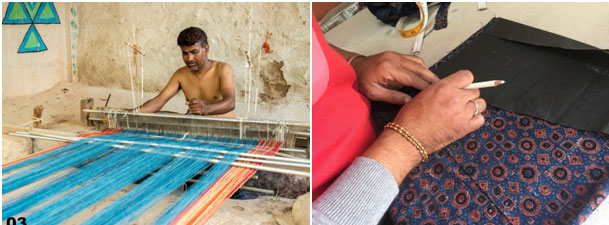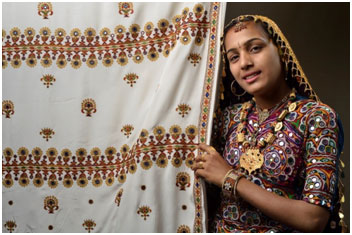 In a first-time-ever,path breaking initiative by IMG Reliance called the Sustainable Fashion & Indian Textiles Day (SFIT), at the Lakme Fashion Week Summer/Resort 2017, nine traditional artisans from Kutch will present contemporary innovations with the heart, soul and excellence of their cultural tradition. Traditional Kutch weaving, Ajrakh prints, Bandhani, Rabari and Suf embroidered saris and ensembles will hit the runway by the Artisans as creators and designers of their collection, bringing to the forefront heritage Indian craft and its journey to contemporary relevance. The ‘Artisans of Kutch’ presentation will be on 2nd February 2017, where seven artisans of Kutch under Somaiya Kala Vidya and 2 independent award winning master-craftsmen will present their striking and innovative textile stories through their collection as designers, breaking the industry norm of craft designed by professional designers and executed by craft technicians. The show will have a special collection from Shrujan, one of the most prominent craft based NGO’s operating in Kutch in India.
In a first-time-ever,path breaking initiative by IMG Reliance called the Sustainable Fashion & Indian Textiles Day (SFIT), at the Lakme Fashion Week Summer/Resort 2017, nine traditional artisans from Kutch will present contemporary innovations with the heart, soul and excellence of their cultural tradition. Traditional Kutch weaving, Ajrakh prints, Bandhani, Rabari and Suf embroidered saris and ensembles will hit the runway by the Artisans as creators and designers of their collection, bringing to the forefront heritage Indian craft and its journey to contemporary relevance. The ‘Artisans of Kutch’ presentation will be on 2nd February 2017, where seven artisans of Kutch under Somaiya Kala Vidya and 2 independent award winning master-craftsmen will present their striking and innovative textile stories through their collection as designers, breaking the industry norm of craft designed by professional designers and executed by craft technicians. The show will have a special collection from Shrujan, one of the most prominent craft based NGO’s operating in Kutch in India.
Commenting on the initiative Jaspreet Chandok, Head- Fashion, IMG Reliance Ltd said, “IMG Reliance has 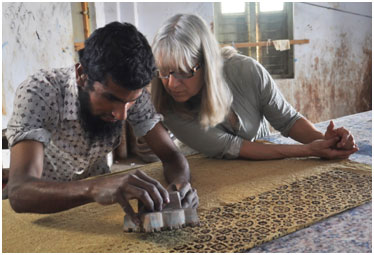 been at the forefront of promoting Indian Handlooms and this show puts the spotlight firmly on an important stakeholder – the artisans that create some of the greatest handloom stories. The team of curators led by Gautam Vazirani have spent months working with key stake-holders from the region to bring this alive on the Lakme Fashion Week ramp and we hope to make this a regular feature at the week going forward.”
been at the forefront of promoting Indian Handlooms and this show puts the spotlight firmly on an important stakeholder – the artisans that create some of the greatest handloom stories. The team of curators led by Gautam Vazirani have spent months working with key stake-holders from the region to bring this alive on the Lakme Fashion Week ramp and we hope to make this a regular feature at the week going forward.”
Judy Frater is the Founder Director of Somaiya Kala Vidya in Kutch, a non-profit institute of education for artisans. She has lived in Kutch, worked with artisans, for over 25 years. SKV offers sustained, coherent programs in design and business for artisans to provide effective, relevant and practical education. Alumni of Somaiya Kala Vidya (SKV) will showcase new collections of saris in a special segment at LFW. The artisans include:
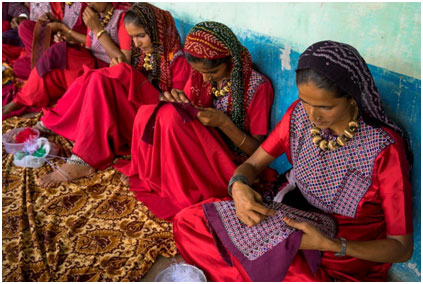 Abdulaziz Alimamad Khatri, who learned the art of bandhani from his family has co-designed his LFW collection with his daughter Tayna. He is inspired by the villages of Kutch. They depicted the fields, homes, animals, and also the migration of villagers to cities. Laxmi Kalyanji Puvar, Tulsiben Purshottam Puvar, Taraben Vijay Puver’sfamilies all migrated from Sindh in 1972, and settled in Faradi. The three young women studied to 7th grade and learned traditional suf embroidery from their mothers. All three did commercial embroidery but did not enjoy it. In 2011 Laxmi and Tulsi studied design, and in 2012 Tara followed. Laxmiben, Tulsiben and Taraben’s collection for LFW is inspired by the branches of trees, geometric, random, reaching.
Abdulaziz Alimamad Khatri, who learned the art of bandhani from his family has co-designed his LFW collection with his daughter Tayna. He is inspired by the villages of Kutch. They depicted the fields, homes, animals, and also the migration of villagers to cities. Laxmi Kalyanji Puvar, Tulsiben Purshottam Puvar, Taraben Vijay Puver’sfamilies all migrated from Sindh in 1972, and settled in Faradi. The three young women studied to 7th grade and learned traditional suf embroidery from their mothers. All three did commercial embroidery but did not enjoy it. In 2011 Laxmi and Tulsi studied design, and in 2012 Tara followed. Laxmiben, Tulsiben and Taraben’s collection for LFW is inspired by the branches of trees, geometric, random, reaching.
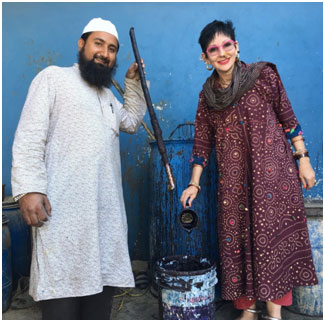 Aakib Ibrahim Khatri’s family have been making Ajrakh for generations. Aakib wants to break the limitations of natural colors and use natural colors which have not been possible till now. After studying design, Aakib began a niche practice, creating small scale, technically skilled production. His specialization is large, one of a kind complex geometric textiles. Aakib’s LFW collection is inspired by Islamic geometry, and Islamic architectural patterns, particularly radiating stars.
Aakib Ibrahim Khatri’s family have been making Ajrakh for generations. Aakib wants to break the limitations of natural colors and use natural colors which have not been possible till now. After studying design, Aakib began a niche practice, creating small scale, technically skilled production. His specialization is large, one of a kind complex geometric textiles. Aakib’s LFW collection is inspired by Islamic geometry, and Islamic architectural patterns, particularly radiating stars.
Monghiben Rana Rabari passed 7th grade, and learned from her mother and neighbors in her Rabari tribe. Monghiben’s LFW collection is inspired by the Ludi, the traditional woolen veil of Rabari women. The sari is also traditional dress. By using the ludi aesthetic on the sari, Monghiben has given tradition a new use.
Dahyalal Atmaram Kudecha belongs to a traditional weaver’s family. He worked under a master weaver and 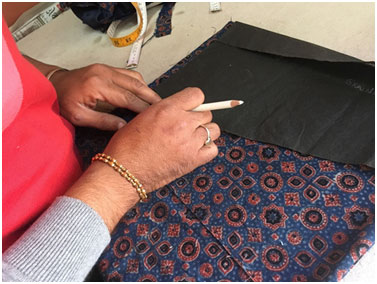 earned his livelihood by weaving traditional and contemporary designs for over 25 years. Dahyabhai’s LFW collection is inspired by winter fog. Sufiyan Khatri is a UNESCO master-craftsmen award winning ajrakh artisan. For 9 generations his family has perfected the art of block printing, specializing in traditional Ajrakh methods using minerals and natural, organic process. Employing age-old techniques to achieve a contemporary aesthetic is Sufiyan’s forte. Sufiyan is collaborating with Australian designer Lisa Hall who combines Kutch textile traditions with theatrical flair and a ‘Sydney street style’ perspective for her label called Madame Hall. The flamboyant presence of Flamingos is the inspiration of Sufiyan Khatri 2017 designs. Together, they will present a contemporary collection of hand-crafted garments for their LFW show.
earned his livelihood by weaving traditional and contemporary designs for over 25 years. Dahyabhai’s LFW collection is inspired by winter fog. Sufiyan Khatri is a UNESCO master-craftsmen award winning ajrakh artisan. For 9 generations his family has perfected the art of block printing, specializing in traditional Ajrakh methods using minerals and natural, organic process. Employing age-old techniques to achieve a contemporary aesthetic is Sufiyan’s forte. Sufiyan is collaborating with Australian designer Lisa Hall who combines Kutch textile traditions with theatrical flair and a ‘Sydney street style’ perspective for her label called Madame Hall. The flamboyant presence of Flamingos is the inspiration of Sufiyan Khatri 2017 designs. Together, they will present a contemporary collection of hand-crafted garments for their LFW show.
Vankar Chaman Siju is the recipient of the President’s National Award in 2001 for his exquisite natural dyed 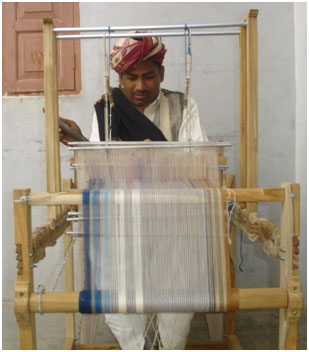 weavings in cotton with supplementary silk weft and has made pioneering efforts in the mix of local sheep wool and silk. His expertise lies in traditional weaving and natural dying. He creates collections with themes “Ocean”, “Festival” and “Desert” and most recently Maldhari, celebrating the herdsmen who are his ancestors. For his LFW show, Chaman Siju is weaving a collection of sari’s on the theme of Holi in organic Kala cotton from NGO Khamir, which is considered as the original and pure old world cotton of India. Khamir’s Kala Cotton Initiative encourages sustainable cotton textile production, and the preservation of agricultural and artisan livelihoods in Kachchh.
weavings in cotton with supplementary silk weft and has made pioneering efforts in the mix of local sheep wool and silk. His expertise lies in traditional weaving and natural dying. He creates collections with themes “Ocean”, “Festival” and “Desert” and most recently Maldhari, celebrating the herdsmen who are his ancestors. For his LFW show, Chaman Siju is weaving a collection of sari’s on the theme of Holi in organic Kala cotton from NGO Khamir, which is considered as the original and pure old world cotton of India. Khamir’s Kala Cotton Initiative encourages sustainable cotton textile production, and the preservation of agricultural and artisan livelihoods in Kachchh.
Founded by Sudha Patel, Shrujan represents different embroidery Crafts of Kutch. Along with Australian designer Pamela Easton, the label will be presenting a collection of youthful and modern women’s wear ensembles with embroideries from Shrujan artisans in the LFW show. Shrujan employs over 5,000 women across 100 villages and does exhibitions of readymade garments and saris all over India. Chandaben Shroff, who developed this unique, sustainable means of income generation for village women works with 16 different styles of embroidery. Each tribal group and community in the area has their own style of embroidery, lexicon of stitches and motifs. Shrujan’s mission is not only to make all the 16 styles popular but also to continue the conversation with the craftswomen and discover even more styles.

